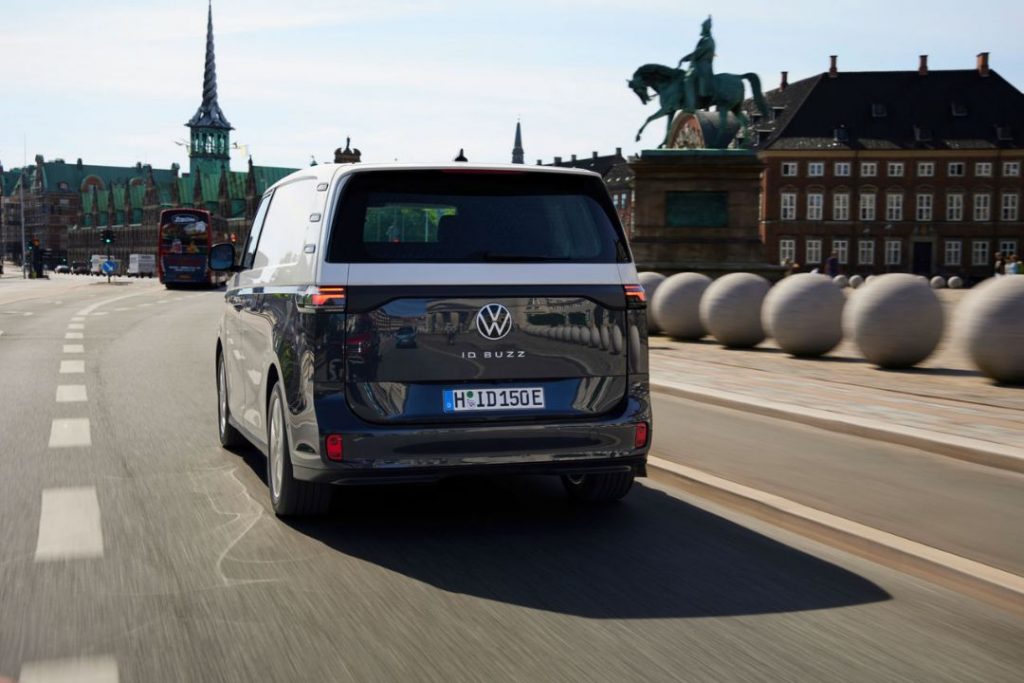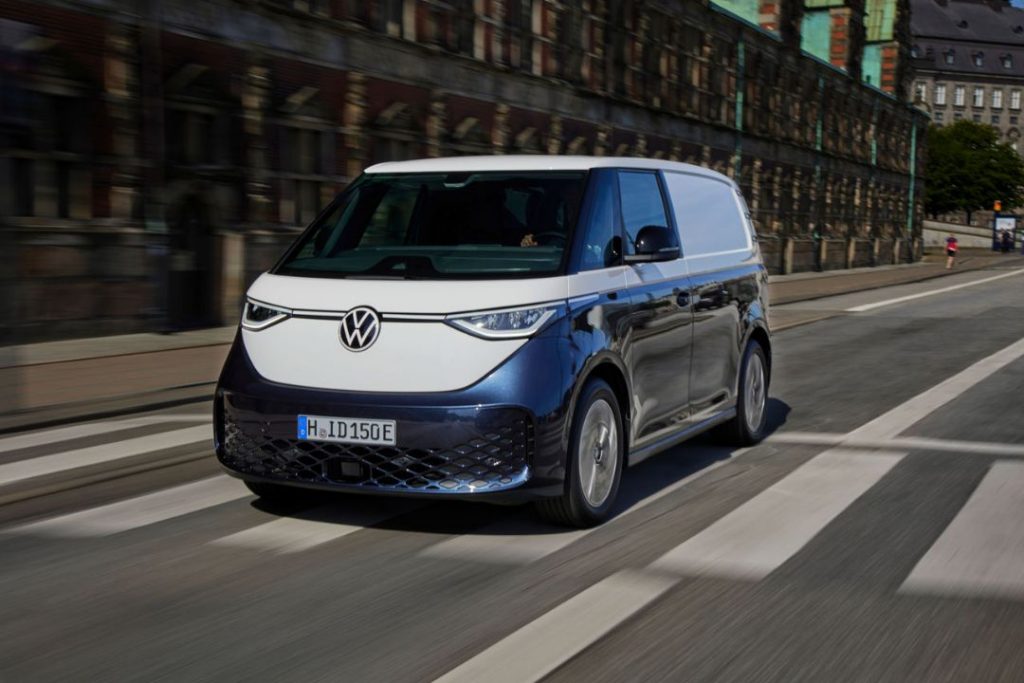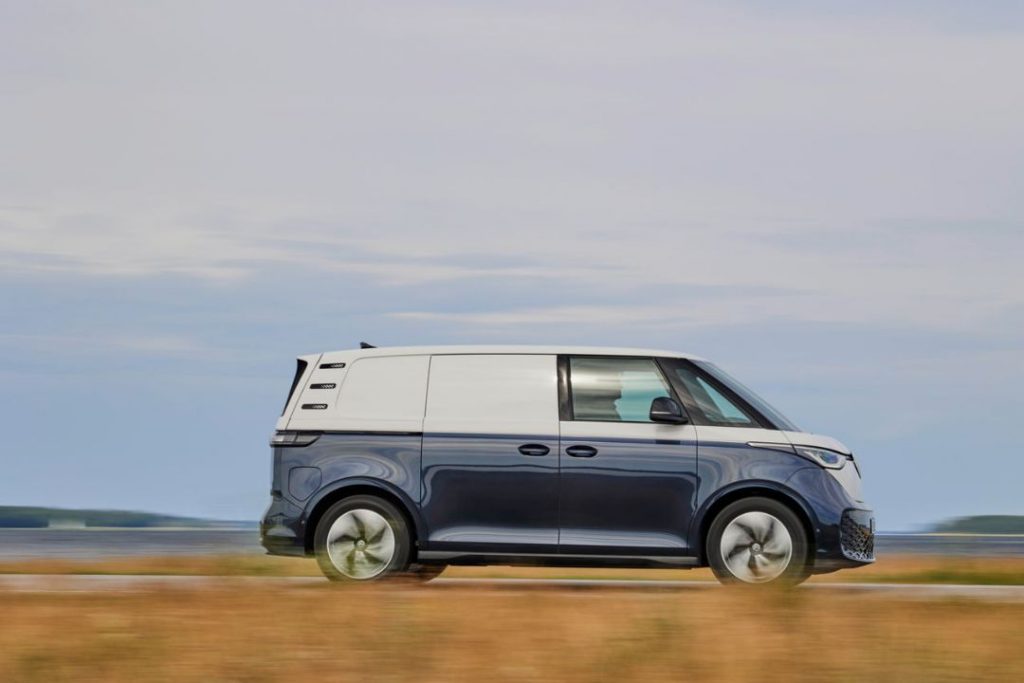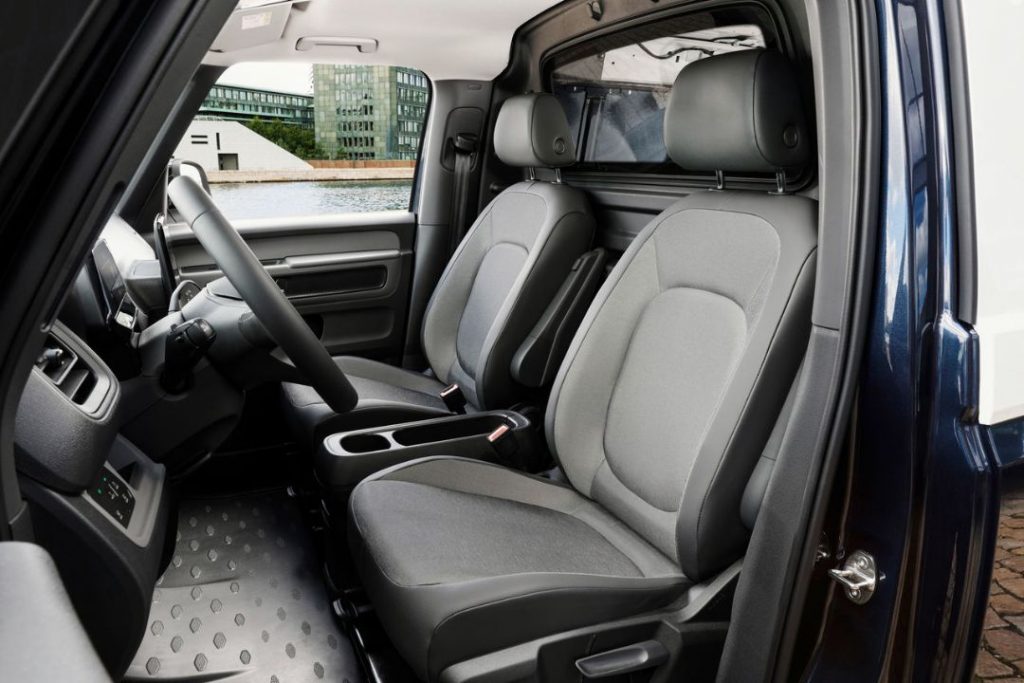Home »

The Volkswagen ID Buzz Cargo is a brand new electric van that takes its inspiration from the classic Volkswagen campervan.
Volkswagen hasn’t given us an electric commercial vehicle yet – well, not a proper one – but that’s all about to change with the ID. Buzz Cargo.
Think of it as a modern interpretation of the Type 2 van synonymous with campervans. It's a halfway house between the Caddy and the Transporter but with an electric powertrain. Look past the swirling rainbow camouflage and you will see VW’s new halo product for an electric generation. ID Buzz will have passenger, campervan, and commercial vehicle versions of this compact but medium-sized van all scheduled to go into production.
If you’re familiar with the passenger car range, think of this as a boxier Volkswagen ID.4 as it is based on the group’s MEB electric vehicle platform – which is exactly where you need to look to determine where this model will be heading.

Launching with a 150kW motor producing 310Nm of torque, driven through the rear wheels, the ID. Buzz Cargo has a 82kWh (gross) 77kWh (usable) battery pack that should make it capable of reaching up to 258 miles on a single charge according to its WLTP figures. Pretty impressive stuff for a van that is not only fast but surprisingly adept in the payload department.
| | Volkswagen ID. Buzz Cargo |
| Electric motor | Permanent-magnet synchronous motor connected to the rear axle |
| Max. power | 150 kW / 204 PS |
| Max. torque | 310 Nm |
| Gearbox | 1-speed gearbox at the back |
| Drive axle | Rear axle |
| Top speed | 145 km/h |
| 0 – 100 km/h | 10.2 seconds |
| Energy capacity (net / gross) | 77 kWh / 82 kWh |
| Max. charging power (AC/DC) | 11 kW / 170 kW |
| Charging time from 0 % to 100 % SOC (for AC charging using 11 kW) | 7:30 h |
| Charging time from 5 % to 80 % SOC (for DC charging using 170 kW) | 0:30 h |
| Energy consumption (WLTP) | 22.2 to 20.4 kWh / 100 km |
| Range (WLTP) | 402 to 425 km |
Its size sees it fit neatly between its siblings, with it being roughly 200mm shorter than the Transporter T6.1 and 200mm longer than the Caddy, but there is a lot more to the ID Buzz Cargo than filling a gap in the product range. That's because as a vehicle conceived as being electric-only it makes fewer compromises than VW’s other electric vans to-date. We're looking at you e-Crafter and ABT e-Transporter.
The van has a 3-tonne GVW with a 648kg payload capacity. That’s perhaps not mind-blowing for the majority of trendy tradesmen who might be tempted by such a nostalgic looking van. But it is in line with payloads from Citroen e-Berlingo, Peugeot e-Partner or Vauxhall Combo-e vans – all of which are marginally smaller but with larger gross weights.

In other words, there’s room for improvement from a commercial vehicle point of view, but given time, that will come. In the meantime, however, the ID Buzz Cargo has a 3.9m3 capacity with a 1.25m of internal height, 1.7m across the width and a 2.2m in length. There’s also the ability for a small load though bulkhead adding an additional 450mm. It’s possible to transport two Euro pallets in the load area. There's also six lashing points, and the option of aeroplane-style load securing rails as well. In other words, it is most definitely trying to be a proper commercial vehicle.
The battery pack, for example is integrated within the chassis which makes the ID. Buzz feel low to the ground and particularly planted. That’s a good thing. And even though it’s rear-wheel-drive layout means that the load area is slightly higher than that of a Caddy van, its not so much that it would pose a problem for loading items into or out of it.
For more on the Volkswagen ID Buzz Cargo dimensions read our in-depth guide
When it comes to driving though, the ID. Buzz is far superior to any of the current VW crop of vans, which is a considerably achievement. It sits on a near 3m wheelbase, but its exceptionally short overhangs makes it feel like half the size. It rides smooth, handles brilliantly and has a turning circle of just 11m – ideal for the city.
The steering is heavier than other Volkswagen vans like the Caddy but it has all the characteristics of the van range with sharp, fast and accurate steering that communicates changes in the ground beneath you. The ID Buzz’s handling is particularly good thanks to its wide track and low centre of gravity with the 82kWh batteries located underneath the loadspace. The van’s party piece is its 11.1m turning circle which contributes to its overall manoeuvrability with short overhangs that allow you to easily judge the extremities of the van.
Hardly surprising though, is that you’d expect anything with a VW badge to be class leading. The ID. Buzz will follow, especially as Caddy is a Golf, and Transporter T6.1 has been one of the best mid-sized vans. The Crafter is also still the most complete of any of the large vans on the market. What the ID. Buzz brings to the table is that same VW dynamic – great to drive, nice to look at, reassuringly expensive but reliable to own.

The headline grabber is that there’s a 12-inch central display for the Volkswagen ID Buzz but Cargo models have a slightly smaller 10-inch version as standard with the 12in as an option. It allows you to control the various driving modes of the van, which include an Eco mode, Comfort setting and a Sport option. The noticeable difference between each is the responsiveness and output of the throttle pedal. The subtle weighting of the steering is also changed. The steering wheel clusters gets a smaller 6-inch display. This feeds back nearly all of the required information to right in front of you.
What isn’t immediately apparent is the work the ID. Buzz will be doing behind the scenes with its Travel Assist system using VW’s new and evolving swarm data capture. It will use other VW Group vehicle’s speed and GPS data to allow the system to learn about lane positioning. As well as other vehicle driving habits on the roads you drive. For example, if you need to avoid driving in the centre of the lane because there are tram tracks. The system will then offset its automatic lane centring to avoid them. Clever stuff and it really works with the help of swarm data captured by other similarly equipped VW Group cars can plot the best position to take on the road.
This can be as simple as the lane positioning, but also how it approaches a curve in the road or when it should slow for an obstacle like a roundabout. It’s another giant step forward for autonomous driving, especially when using the assisted lane change on a motorway which will safely switch lanes at a touch of the indicator.

The inside of the Volkswagen ID Buzz Cargo is a mixture of ID.4 passenger car and your typical VW commercial vehicle. In a way that’s no bad thing, it’s got a smart digital display, large infotainment screen and quirky ID Light system that illuminates the dashboard with different colours depending on the car’s charging conditions, navigation directions and even emergency braking requirements. There’s voice assistance which can answer, interpret and perform tasks like finding a charging point when speaking natural to it in a conversational style.
But despite all of that, the van feels a bit sterile and bland. When so much styling and thought has been put into the passenger car variant, the Cargo seems boring in comparison. Apart from the spilt compartments in the dash (which will become a dumping ground for all manner of things both good and bad) it lacks useful, practical storage for the driver and passenger beyond some mid-dash height trays and the glovebox.
The seats are comfortable and the screens and touchpoints feel of a high quality but acres of flat grey are jarring when you consider the funky looks and optional two-tone paintwork inspired by the Multivan.
Vans come as standard with three seats in the cab, a driver’s seat plus double bench seat, but there’s the option of an individual seat for the front-seat passenger. With its wide cabin and no obstacles like handbrakes or gear levers in the dash area around the middle seat there’s plenty of space for driver and passengers.

Perhaps the most appealing and intriguing idea is that you can teach it to perform parking manoeuvres using the Park Assist function. Say, for example, you have a tricky driveway entry to do each night. Maybe there’s a pillar or wall you need to carefully negotiate, the ID. Buzz will learn the process and replicate it.
Far from being just another electric van, VW has adopted a whole new platform on which its future vehicles will be not only electrified but more connected and more intelligent as well. The ID. Buzz is a brilliant example of what an electric van can be when designed from a blank sheet.
Most manufacturers have been cautiously rolling out their new electric vans with just a single body size, testing the water and limiting their risk in what is still a fairly niche sector. While the Volkswagen ID Buzz Cargo is arriving in October with just the one variant, it’s not likely to remain that way. For starters, an ID. California camper van variant is due after 2025, which will be based on a long wheel-base model. That will mean an increase in gross vehicle weight from 2.4-tonnes to 3-tonnes and will come with the option of an even larger battery pack.
But there will be more developments that aren’t yet official and it is the recently launched Volkswagen ID.4 which gives the best indication as to what the future product line-up for the ID. Buzz Cargo might include.
While it’s 250 mile range will be celebrated, in reality it's greater than many commercial vehicle customers will need. It also adds additional weight (sacrificing payload) and cost to the van. Expect a smaller battery option similar to the 52kWh pack currently offered on the ID.4 car. That will likely knock around 40% off the van’s overall range. But with support for rapid charging at 115kW a quick top-up of 30 minutes will restore up to 80% capacity.
One final variant will likely be an all-wheel-drive model. As an SUV, there is a 4x4 version of the ID.4 but electric motors in the rear and the front of the ID Buzz Cargo would allow Volkswagen to use the 4Motion badge once again.
You may not be able to get the ID Buzz Cargo in quite the number of variants that you can currently choose from on a Transporter, but VW isn’t serving up a one-size fits all offering either.
Scheduled to go on sale later this year, the ID Buzz Cargo will sit in the Volkswagen range between the Volkswagen Caddy and the Volkswagen Transporter T6.1 with a van model and an MPV people carrier model.
Rumour has it that there will also be a self-driving ID Buzz model on the market sometime after 2025.
It's already racking up a tonne of awards both as a passenger car and a van. Most notably, the Volkswagen ID Buzz Cargo was named International Van of the Year 2023 at a ceremony in Hanover, Germany in September 2022. The prize is awarded to a light commercial vehicle that has made the largest contribution to the sector with its innovation and abilities.
The ID Buzz Cargo won the contest scoring 110 points from a jury of 25 international journalists, narrowly beating the Ford E-Transit which scored an impressive 100 points. Also in contention were the Renault Kangoo E-Tech, Mercedes Benz eCitan and the Nissan Townstar Electric.
Yes. The ID Buzz Cargo. is fitted with a wide range of active and passive safety features from emergency braking to emergency messaging. It's even got more airbags and your average van too.
Not only is it filled with safety equipment, it's also one of only a very few vans to be awarded a Platinum rating from Euro NCAP. The ID Buzz scored a rating of 83% with the highest "Good" rating level for four out of six categories - AEB Car-to-Car, Lane Support Systems, Speed Assist Systems and Occupant Status Monitoring.

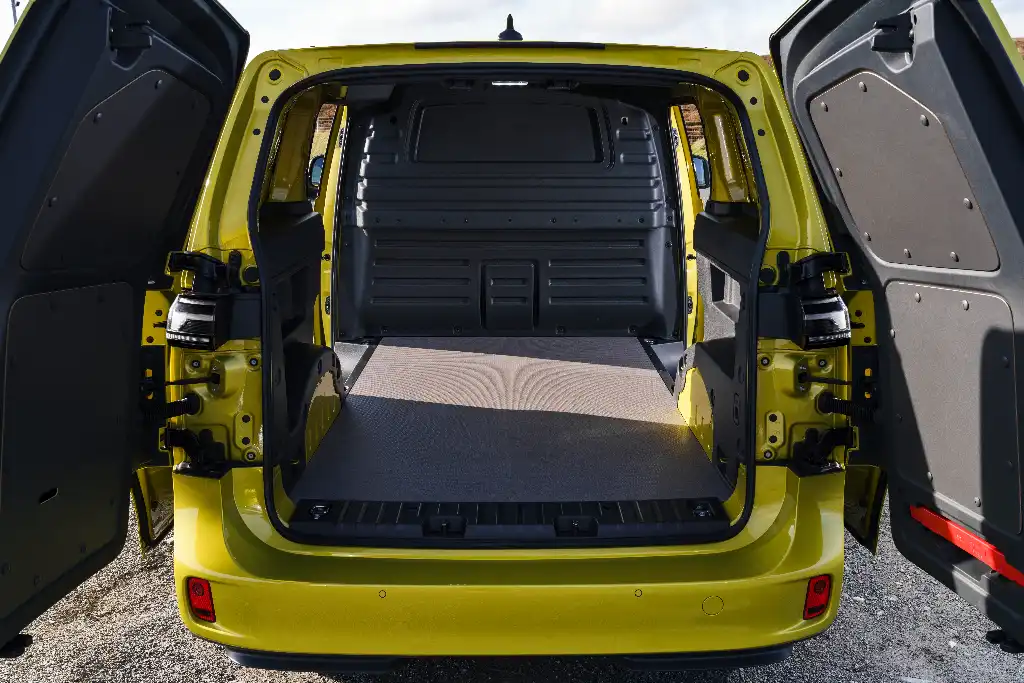
The ID Buzz Cargo screams retro cool, so if that suits you then definitely go and buy one. It looks great in its two tone paintwork, and will look elegant with a livery. If you want something for mobile branding then the ID Buzz Cargo will make you stand out.
When it comes to the driving of the van, it's typically Volkswagen. It's a comfortable and enjoyable van to be in, but it's a bit dull to look at on the inside.
The ID Buzz Cargo is super practical but again it sits in between two other models in the range. Of course you can't have an electric version of either the Caddy or the Transporter T6.1 yet. If you really want an EV commercial vehicle from VW then this will be your only option.
But that's no bad thing. The electric drivetrain and the technology behind it are cutting edge and it will only get smarter. The ID Buzz Cargo and its software systems will evolve with the van which is really promising.
A significant factor will be the price. At more than £38,000 for the base model it's a big outlay. But if you like the looks, the image it portrays and are taken by the tech, it's a great van.


